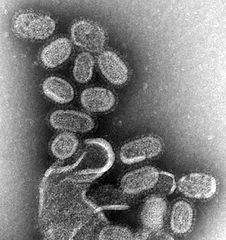Cross posted from Next big future
Since a journal article was submitted to the Royal Society of Chemistry, the U of Alberta researchers have already made the processor and unit smaller and have brought the cost of building a portable unit for genetic testing down to about $100 Cdn. In addition, these systems are also portable and even faster (they take only minutes). Backhouse, Elliott and McMullin are now demonstrating prototypes of a USB key-like system that may ultimately be as inexpensive as standard USB memory keys that are in common use – only tens of dollars. It can help with pandemic control and detecting and control tainted water supplies.
This development fits in with my belief that there should be widespread inexpensive blood, biomarker and genetic tests to help catch disease early and to develop an understanding of biomarker changes to track disease and aging development. We can also create adaptive clinical trials to shorten the development and approval process for new medical procedures
![]()
The device is now much smaller than size of a shoe-box (USB stick size) with the optics and supporting electronics filling the space around the microchip
Canadian scientists have succeeded in building the least expensive portable device for rapid genetic testing ever made. The cost of carrying out a single genetic test currently varies from hundreds to thousands of pounds, and the wait for results can take weeks. Now a group led by Christopher Backhouse, University of Alberta, Edmonton, have developed a reusable microchip-based system that costs just 500 (pounds) to build, is small enough to be portable, and can be used for point-of-care medical testing.
To keep costs down, ‘instead of using the very expensive confocal optics systems currently used in these types of devices we used a consumer-grade digital camera’, Backhouse explained.
The device can be adapted for used in many different genetic tests. ‘By making small changes to the system you could test for a person’s predisposition to cancer, carry out pharmacogenetic tests for adverse drug reactions or even test for pathogens in a water supply,’ said Backhouse.
The heart of the unit, the ‘chip,’ looks like a standard microscope slide etched with fine silver and gold lines. That microfabricated chip applies nano-biotechnologies within tiny volumes, sometimes working with only a few molecules of sample. Because of this highly integrated chip (containing microfluidics and microscale devices), the remainder of the system is inexpensive ($1,000) and fast.
There are many possible uses for such a portable genetic testing unit:
Backhouse notes that adverse drug reactions are a major problem in health care. By running a quick genetic test on a cancer patient, for example, doctors might pinpoint the type of cancer and determine the best drug and correct dosage for the individual.
Or health-care professionals can easily look for the genetic signature for a virus or E. coli – also making it useful for testing water quality.
“From a public health point of view, it would be wonderful during an epidemic to be able to do a quick test on a patient when they walk into an emergency room and be able to say, ‘you have SARS, you need to go into that (isolation) room immediately.’ ”
A family doctor might determine a person’s genetic predisposition to an illness during an office visit and advise the patient on preventative lifestyle changes.
FURTHER READING
Microfabrication technologies research at the University of Alberta
Rapid genetic analysis
In collaboration with the Glerum Lab we have been developing microchip based implementations of genetic amplification (PCR — the polymerase chain reaction) and capillary electrophoresis (CE) that are extremely fast.
- Cancer diagnostics
- Cell manipulation on a chip
- On chip PCR (polymerase chain reaction)
- Single cell PCR
- DNA Sequencing
 What would make this new vaccine different from the ones already available is that it would target M2e, a conserved region of influenza “A” strains. Since that part doesn’t constantly mutate and about 2/3 of seasonal epidemics and all pandemics are due to type “A” strains, it could be a very efficient weapon against repeats of the “Spanish Flu” (1918−1919) that killed at least 50 million people worldwide. Only the future will tell if phase II and III trials are successful.
What would make this new vaccine different from the ones already available is that it would target M2e, a conserved region of influenza “A” strains. Since that part doesn’t constantly mutate and about 2/3 of seasonal epidemics and all pandemics are due to type “A” strains, it could be a very efficient weapon against repeats of the “Spanish Flu” (1918−1919) that killed at least 50 million people worldwide. Only the future will tell if phase II and III trials are successful.